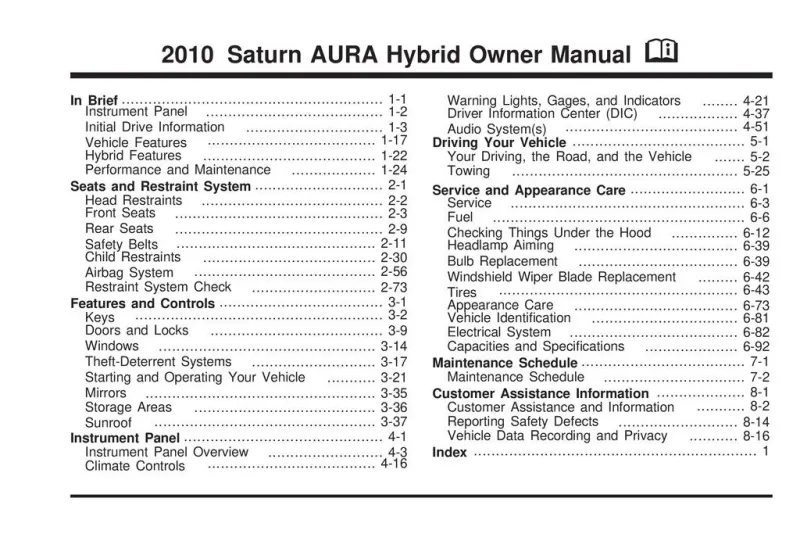2010 Saturn Aura Hybrid Owner's Manual

Table of Contents
2010 Saturn Aura Hybrid Overview
Introduction
The 2010 Saturn Aura Hybrid stands as a remarkable example of innovative engineering, showcasing the blend of performance, efficiency, and comfort that defines modern hybrid vehicles. This stylish sedan not only appeals to eco-conscious drivers but also delivers a responsive driving experience, making it a versatile choice for urban and highway travel alike.
Powertrains
At the heart of the Aura Hybrid is a sophisticated 2.4-liter four-cylinder engine paired with an electric motor, delivering a combined output of 169 horsepower. The hybrid system is mated to a seamless electronic continuously variable transmission (eCVT), which optimizes power delivery and fuel efficiency. The Aura Hybrid boasts an impressive EPA rating of approximately 25 mpg in the city and 34 mpg on the highway, making it a prudent option for daily commutes and long road trips.
Trims
The 2010 Saturn Aura Hybrid is available in the well-equipped base trim and a more luxurious Green Line trim. The base trim includes key amenities such as air conditioning, cruise control, and a four-speaker audio system, while the Green Line trim enhances the vehicle with additional features like a power-adjustable driver’s seat, premium sound system, and upgraded interior materials, offering drivers an added touch of elegance.
Features
The Aura Hybrid comes loaded with convenience and safety features. Standard offerings include keyless entry, power windows and locks, and a full suite of airbags. Additionally, the voice-activated navigation system, Bluetooth connectivity, and optional leather upholstery cater to tech-savvy users seeking comfort and functionality.
Owner's Manual
The owner's manual for the 2010 Saturn Aura Hybrid serves as an essential guide for new owners, providing detailed information about vehicle operation, maintenance schedules, and troubleshooting tips. It includes valuable resources for understanding the hybrid technology, ensuring optimal performance, and extending the life of the vehicle. The manual emphasizes the importance of regular maintenance and offers insights into maximizing fuel economy, allowing owners to fully enjoy their Saturn Aura Hybrid experience.
User manual download
The Saturn Aura Hybrid owner manual for the 2010 model year is to be found in PDF downloadable format on this page. The owner manual for the model year 2010 is free and in English, but the repair manuals are usually not easy to get and may cost more.
Manual Questions
Fill the form below and someone will help you!
